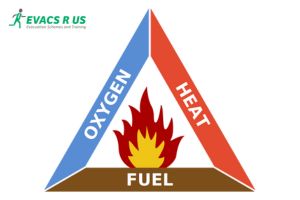The Science of Combustion

Fire is a powerful and destructive force capable of causing immense harm to people and property. To effectively combat and prevent fires, it’s crucial to understand the science behind them. One fundamental concept that forms the basis of fire training is the Fire Triangle.
Fire is a chemical reaction that occurs when three essential components come together, forming what is known as the Fire Triangle. These components are fuel, oxygen, and heat. Understanding the Fire Triangle is the cornerstone of fire safety and firefighting.
Understanding the Fire Triangle
The Fire Triangle represents the three elements that must be present for a fire to ignite and continue to burn. Remove any one of these elements, and the fire will be extinguished. Let’s delve into each of these components:
Components of the Fire Triangle
Fuel
Fuel is any substance that can burn. It can be a solid, liquid, or gas. Common examples of fuel include wood, gasoline, paper, and even metals. Identifying and managing fuel sources is a critical aspect of fire prevention and safety.
Oxygen
Oxygen is the oxidizing agent that sustains combustion. Fires require a certain concentration of oxygen in the air to burn. Reducing the oxygen supply can be an effective way to control or extinguish a fire.
Heat
Heat is the energy required to initiate the combustion process. It can be in the form of a spark, flame, or even high temperatures. Controlling the heat source is essential for fire prevention and safety.
The Role of Fire Training
Now that we understand the Fire Triangle, it’s clear that effective fire training plays a vital role in managing and preventing fires. Firefighters, as well as individuals in various industries, receive fire training to become proficient in handling fire-related situations.
Fire Training Procedures
Identifying Fire Hazards
Effective fire training begins with identifying potential fire hazards in the environment. This involves recognizing fuel sources, assessing fire risks, and taking preventive measures.
Fire Prevention
Preventing fires is often more critical than fighting them. Fire training emphasizes the importance of fire prevention through safe practices, proper storage of flammable materials, and the correct use of electrical equipment.
Emergency Response
In the event of a fire, knowing how to respond is crucial. Fire training provides individuals with the knowledge to act swiftly and efficiently during a fire emergency, reducing the risk of injury and property damage.
The Benefits of Effective Fire Training
Effective fire training offers numerous benefits, such as increased safety, reduced property damage, and, most importantly, saved lives. It ensures that individuals are well-prepared to respond to fire incidents, ultimately minimizing the devastating impact of fires.
The Importance of Fire Drills
Fire drills are an integral part of fire training. They simulate real-life fire emergencies, allowing individuals to practice their response and evacuation procedures. Regular fire drills in schools, workplaces, and residential buildings can save lives by ensuring that people know what to do in case of a fire.
Understanding the Fire Triangle and the significance of fire training is paramount in ensuring the safety of individuals and property. By comprehending the three essential components of fuel, oxygen, and heat, and by receiving appropriate training, we can significantly reduce the risks associated with fires. Regular fire drills and proper emergency response procedures further enhance our ability to manage fire-related situations effectively.
Remember, in the face of fire, knowledge and training are your most valuable assets. Stay safe, and always be prepared.



